Today, we're diving into BEAMS. They are a fundamental aspect of almost every building’s structural anatomy. Beams play a vital role in supporting and distributing the weight and loads imposed on the entire structure. Everything from stairs, walkways, decks, floor/roof diaphragms, and rough openings to name a few.
As building envelope consultants specializing in healing sick buildings, we're on a mission to uncover the mysteries lurking within beams, and we want to take you along for the ride! Join us as we explore the materials, methods, and tools used to reveal hidden damage and examine these essential components of our built environment.
What is a beam?
Without getting too technical, a beam is generally a long, slender structural member with a uniform cross-sectional area supporting loads perpendicular to its axis. You might be familiar with terms like joists, rafters, girder, or stair stringers—all of these serve as types of beams. From simply supported beams (supported on either end) to cantilever beams (fixed on one end and free on the other), beams can be loaded and supported in many different configurations making them vital components in engineering and architectural design.
As building envelope consultants, or Building Doctors, our role involves conducting visual observations of low-rise structures from the top of the roof ridge down to the dark damp crawlspace below and everywhere between. Our process–we diagnose the damage, prescribe the repair, and oversee the treatment process for sick buildings.
Beam Materials
Most common beam materials (Pacific Northwest/PNW)
- Wood: Species like Douglas Fir (DF), Hemlock Fir (hem-fir), and Western Red Cedar are most common in the Pacific Northwest. Much of the engineered lumber like Glulam, Laminated Veneer Lumber (LVL), and Parallel Strand Lumber (PSL) are manufactured locally in the PNW as well.
- PT lumber: Timber that has been incised and treated with preservatives intended to help prevent damage that can be caused by prolonged exposure to the outdoor elements.
- Concrete: Reinforced concrete beams are used in many applications from skyscrapers to parking garages.
- Steel: Structural steel is incredibly strong, accessible, durable, and commonly used in all types of construction.
We see a variety of beam materials on our projects, ranging from various types of wood, steel, and concrete. But when it comes to materials, especially here in the Pacific Northwest, timber reigns supreme (in my opinion). Species like Douglas Fir and Hem-Fir are prevalent in our region, and all species of timber have different strength properties. For instance, while Douglas Fir is plentiful and commonly used for framing homes due to its strength, Hem-Fir is favored for preservative treatment as it absorbs the treating chemicals more effectively, giving exterior structures like decks and entry stairways a fighting chance in exposure and inclement weather. In the same sense, Hem-Fir is not as strong as Douglas Fir so we need to consider all these material properties when designing and implementing repairs.
Secrets of Structural Investigations: Tools of the Trade
Let’s talk about the tools we use to identify beams that have failed due to water intrusion, improper construction, or other various defects.
Tools Under $10:
Eyes: When it comes to investigating structural issues, our eyes are our primary tool. With years of experience in construction and engineering, our team has honed its observational skills to detect subtle signs of damage or deterioration. Whether it's a hint of staining, a change in texture, or the appearance of peeling paint, we're trained to spot potential problems. Don’t be discouraged, though—anyone can look around a property and learn to identify symptoms of damage, and it doesn’t take much to spot a beam that is dripping with moisture on a dry day.
Sounding: Sometimes called the "watermelon test," sounding is a simple and effective attempt to detect less dense or hollow spaces by knocking on wood (non-superstitiously) and listening to the sound produced when tapping on the material. Does it sound solid or hollow? If you know what a healthy beam sounds like, this can be an effective way of locating structural members that require more testing. It's a technique developed through experience, where subtle nuances in sound can reveal underlying issues.
Pen/pencil: The next easiest way of detecting damage is using a highly sophisticated tool called a pen or pencil. Even as experienced engineers and project managers, we still pull out a pen or pencil to poke at materials that should be more rigid but often become soft enough from water damage to drive a pen through.
Awl/screwdriver: In every building inspector’s toolkit. These are more robust probing tools that serve essentially the same purpose as the pen or pencil above.
$20 - $2,000:
Data loggers: We utilize data loggers and relative humidity sensors to gather long-term data on temperature and moisture levels in places like basements, crawlspaces, and attics which are common areas for moisture intrusion and ventilation concerns. By monitoring these areas over time, we can identify trends and use this data to assist in developing a comprehensive plan.
Moisture meters: These can be both invasive and noninvasive and are an excellent tool for helping identify water damage. By pinpointing areas of high moisture content, we can better trace the source of leaks and address them before they cause further harm.
Thermal imaging cameras: Although these are not “damage detectors” or even “water detectors,” they do provide another layer of insight, highlighting temperature changes that may indicate hidden moisture or air leakage in wall cavities or beneath floor coverings, to name a few.
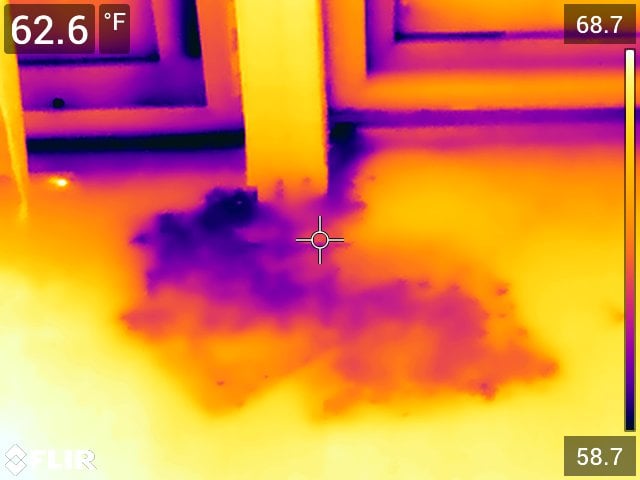
Specialty Tools and Diagnostic Methods
J2 has a few more tricks up our sleeve to help us detect possible hidden damage in beams. There are forms of water damage in wood that is undetectable to the human eye. Insipient decay can only be seen microscopically and can result in a significant loss of strength. Although the tools above are highly effective, additional methods are sometimes needed to assist in our investigations.
Stress wave testing (hammer): A noninvasive method of investigation that can provide valuable insights into the condition of wooden substrates. Picture a hammer in one hand and a doctor’s stethoscope-like device in the other. The head of the hammer and the stethoscope are accelerometers which, without getting too technical, measure the acceleration of stress waves in this instance. By placing the “stethoscope side” on the face of a wood beam and tapping the opposite face of that beam we are sending a stress wave through that material. This setup allows us to measure the time it takes for a stress wave to travel through the material from point to point.
In pristine lumber, with tight grain and no knots, the stress wave encounters minimal resistance, resulting in a swift transmission time. However, as the wood fibers degrade due to factors like water damage, the signal must navigate around obstacles like voids and changes in density causing the transmission time to increase. The United States Department of Agriculture (USDA) has compiled helpful data on stress wave transmission times for various wood types and moisture contents. Using this information, we can interpret our field findings and attempt to better assess the extent of structural damage.
.png?width=808&height=597&name=Stress%20Wave%20Testing%20Labeled%20(2).png)
Table clamp: Another type of stress wave device, the table clamp can be deployed to non-invasively measure stress waves across sheet materials such as plywood and oriented strand board (OSB). Using a pendulum hammer to send signals through accelerometers, the table clamp records the time it takes for vibrations (stress waves) to pass through the materials. This data is then analyzed and can be utilized to help rank the quality of the material on the factory line or in the field. By comparing readings from new, undamaged substrates to those exhibiting signs of water damage or deterioration, we gain a deeper understanding of the potential degradation of the material.
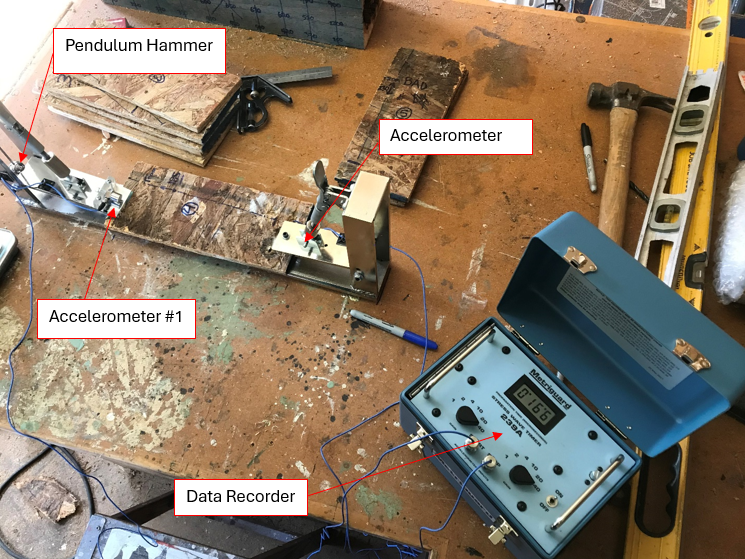
Resistance drilling: A specialized device that attaches to a regular cordless drill. The technician identifies specific locations on the beam to be tested, typically in the middle span where the bending stress on the beam is the greatest, and drills a small hole through the wood while the device measures the resistance in real time.
As the drill bit advances into the wood, the device graphs the resistance encountered, creating a visual representation like a heart rhythm on an EKG or earthquake activity on a seismograph. This graph allows us to see any deviations or anomalies in resistance, such as voids or hollow sections within the beam.
By analyzing the data collected from resistance drilling, we can make informed decisions about the condition of the structure. For example, if the drilling reveals a significant void or lack of resistance in a beam, it may indicate advanced internal damage, prompting further investigation or repair.
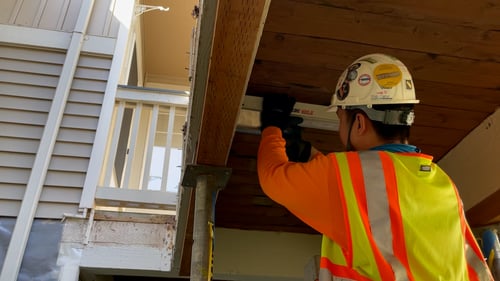
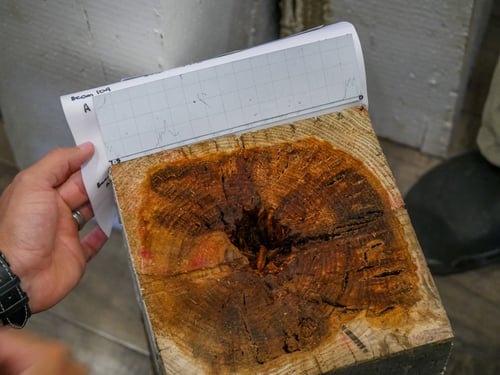
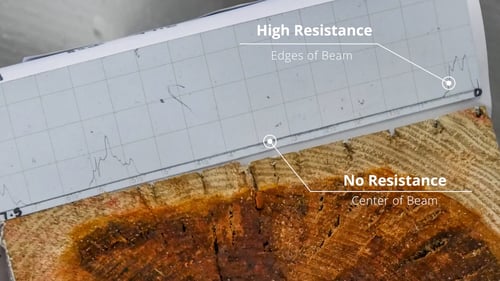
As building envelope consultants, our focus extends beyond aesthetics—we specialize in weatherization details that ensure the long-term structural integrity of condominiums, apartments, and commercial buildings. Rather than opting for quick fixes that may deteriorate over time, our goal is to provide durable solutions and comprehensive repair plans that prioritize safety and longevity that will withstand the test of time.
In our reports, we strive to convey the full picture, utilizing both visual observations and data collected with the tools in our arsenal. Each detail, from the condition of the sheathing to the moisture content of structural members, shapes our conclusions and recommendations to building owners, managers, and board members.
There's no one-size-fits-all solution to structural investigations. Instead, we rely on a combination of tools and techniques along with our years of experience, blending traditional methods with technology to diagnose damage and help our clients make their buildings healthy again.
To watch examples of each of these tools in action, sign up for our free monthly webinar, The Building Doctor Show, and watch the March 2024 episode on Beams!